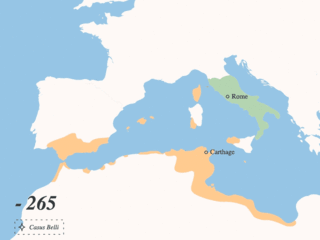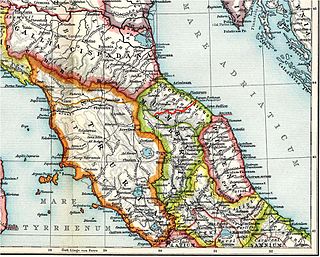
The First Punic War was the first of three wars fought between Rome and Carthage, the two main powers of the western Mediterranean in the early 3rd century BC. For 23 years, in the longest continuous conflict and greatest naval war of antiquity, the two powers struggled for supremacy. The war was fought primarily on the Mediterranean island of Sicily and its surrounding waters, and also in North Africa. After immense losses on both sides, the Carthaginians were defeated and Rome gained territory from Carthage.

The Punic Wars were a series of wars between 264 and 146 BC fought between the Roman Republic and Ancient Carthage. Three wars took place, on both land and sea, across the western Mediterranean region and involved a total of forty-three years of warfare. The Punic Wars are also considered to include the four-year-long revolt against Carthage which started in 241 BC. Each war involved immense materiel and human losses on both sides.

The Second Punic War was the second of three wars fought between Carthage and Rome, the two main powers of the western Mediterranean in the 3rd century BC. For 17 years the two states struggled for supremacy, primarily in Italy and Iberia, but also on the islands of Sicily and Sardinia and, towards the end of the war, in North Africa. After immense materiel and human losses on both sides, the Carthaginians were once again defeated. Macedonia, Syracuse and several Numidian kingdoms were drawn into the fighting, and Iberian and Gallic forces fought on both sides. There were three main military theatres during the war: Italy, where Hannibal defeated the Roman legions repeatedly, with occasional subsidiary campaigns in Sicily, Sardinia and Greece; Iberia, where Hasdrubal, a younger brother of Hannibal, defended the Carthaginian colonial cities with mixed success before moving into Italy; and Africa, where Rome finally won the war.
The Battle of Zama was fought in 202 BC in what is now Tunisia between a Roman army commanded by Scipio Africanus and a Carthaginian army commanded by Hannibal. The battle was part of the Second Punic War and resulted in such a severe defeat for the Carthaginians that they capitulated, while Hannibal was forced into exile. The Roman army of approximately 30,000 men was outnumbered by the Carthaginians who fielded either 40,000 or 50,000; the Romans were stronger in cavalry, but the Carthaginians had 80 war elephants.
Gnaeus Cornelius Scipio Calvus was a Roman general and statesman during the third century BC. He played a major part in the Second Punic War, establishing Roman rule in the east of the Iberian peninsula and tying up several Carthaginian armies to keep them from reinforcing Hannibal.

The Battle of the Trebia was the first major battle of the Second Punic War, fought between the Carthaginian forces of Hannibal and a Roman army under Sempronius Longus on 22 or 23 December 218 BC. Each army had a strength of about 40,000 men; the Carthaginians were stronger in cavalry, the Romans in infantry. The battle took place on the flood plain of the west bank of the lower Trebia River, not far from the settlement of Placentia, and resulted in a heavy defeat for the Romans.
Mago Barca was a Carthaginian, member of the Barcid family, who played an important role in the Second Punic War, leading forces of Carthage against the Roman Republic in Iberia and northern and central Italy. Mago was the third son of Hamilcar Barca, was the brother of Hannibal and Hasdrubal, and was the brother-in-law of Hasdrubal the Fair.

The Battle of the Lipari Islands or Battle of Lipara was a naval encounter fought in 260 BC during the First Punic War. A squadron of 20 Carthaginian ships commanded by Boödes surprised 17 Roman ships under the senior consul for the year Gnaeus Cornelius Scipio in Lipara Harbour. The inexperienced Romans made a poor showing, with all 17 of their ships captured, along with their commander.

The Battle of Mylae took place in 260 BC during the First Punic War and was the first real naval battle between Carthage and the Roman Republic. This battle was key in the Roman victory of Mylae as well as Sicily itself. It also marked Rome's first naval triumph and also the first use of the corvus in battle.

Hasdrubal Barca, a latinization of ʿAzrubaʿal son of Hamilcar Barca, was a Carthaginian general in the Second Punic War. He was the brother of Hannibal and Mago Barca.
The Battle of the Upper Baetis was a double battle, comprising the battles of Castulo and Ilorca, fought in 211 BC during the Second Punic War between a Carthaginian force led by Hasdrubal Barca and a Roman force led by Publius Cornelius Scipio and his brother Gnaeus. The immediate result was a Carthaginian victory in which both Roman brothers were killed. Before this defeat, the brothers had spent seven years campaigning against the Carthaginians in Hispania, thus limiting the resources available to Hannibal, who was simultaneously fighting the Romans in Italy.

The Battle of Cissa was part of the Second Punic War. It was fought in the fall of 218 BC, near the Celtic town of Tarraco in north-eastern Iberia. A Roman army under Gnaeus Cornelius Scipio Calvus defeated an outnumbered Carthaginian army under Hanno, thus gaining control of the territory north of the Ebro River that Hannibal had just subdued a few months prior in the summer of 218 BC. This was the first battle that the Romans had ever fought in Iberia. It allowed the Romans to establish a secure base among friendly Iberian tribes, and due to the eventual success of the Scipio brothers in Spain, Hannibal looked for but never received reinforcements from Spain during the war.

The Battle of Decimomannu or Battle of Caralis was fought 215 BC on the island of Sardinia when a Carthaginian army sailed to the island to support a local revolt against Roman rule. The army, led by Hasdrubal the Bald, fought a similar size Roman army under the praetor Titus Manlius Torquatus in the Fall of 215 BC somewhere between Sestu and Decimomannu, just north of Caralis. The Romans destroyed the Carthaginian army and then scattered their fleet in a sea battle south of Sardinia.

The Battle of Ibera, also known as the Battle of Dertosa, was fought in the spring of 215 BC on the south bank of the Ebro River near the town of Ibera and was part of the Second Punic War. A Roman army, under the command of the brothers Gnaeus and Publius Scipio, defeated a similarly sized Carthaginian army under Hasdrubal Barca. The Romans, under Gnaeus Scipio, had invaded Iberia in late 218 BC and established a foothold after winning the Battle of Cissa. This lodgement, on the north-east Iberian coast, between the Ebro and the Pyrenees, blocked the route of any reinforcements from Iberia for the army of Hannibal, who had invaded Italy from Iberia earlier in the year. Hasdrubal attempted to evict the Romans in 217 BC, but this ended in defeat when the Carthaginian naval contingent was mauled at the Battle of Ebro River.

The Battle of Lilybaeum was the first clash between the navies of Carthage and Rome in 218 BC during the Second Punic War. The Carthaginians had sent 35 quinqueremes to raid Sicily, starting with Lilybaeum. The Romans, warned by Hiero of Syracuse of the coming raid, had time to intercept the Carthaginian contingent with a fleet of 20 quinqueremes and managed to capture several Carthaginian ships.

The Battle of the Rhône Crossing was a battle during the Second Punic War in September of 218 BC. Hannibal marched on the Italian Alps, and an army of Gallic Volcae attacked the Carthaginian army on the east bank of the Rhône. The Roman army camped near Massalia. The Volcae tried to prevent the Carthaginians from crossing the Alps and invading Italy.
The battle of New Carthage took place in early 209 BC when a Roman army under Publius Cornelius Scipio successfully assaulted New Carthage, the capital of Carthaginian Iberia, which was defended by a garrison under Mago. The battle was part of the Second Punic War.
This section of the timeline of Hispania concerns Spanish and Portuguese history events from the Carthaginian conquests to before the barbarian invasions.

The Battle of Silva Litana was an ambush that took place in a forest 75 miles northwest of the Roman city of Ariminum during the Second Punic War in 216 BC. The Gallic Boii surprised and destroyed a Roman army under the consul-elect Lucius Postumius Albinus. Of 25,000 Romans, only 10 survived, with a few being taken prisoner by the Gauls. The corpse of Postumius was decapitated and his skull was made into a gilded ceremonial cup by the Boii. News of this military disaster probably reached Rome after the defeat at Cannae in the fall of 216 BC or the spring election of consuls for 215 BC, triggering a renewed panic. The Romans were compelled to postpone military operations against the Gauls until the conclusion of the Second Punic War, sending only two legions to guard against additional Gallic attacks. However, the Boii and Insubres did not attempt to exploit their victory. Cisalpine Gaul remained in relative peace until 207 BC, when Hasdrubal Barca arrived there with his army from Spain.














